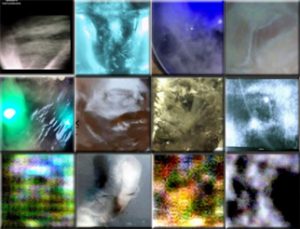Opinion 11
This study has been discontinued. See ATransC Web Page
Abstract
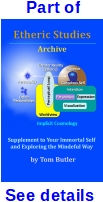 The first part of this essay includes an in-depth discussion of the nature of visual ITC. Emphasis is on transform phenomena that are collected as apparently paranormal features formed in visual noise. The more common characteristics are described, including some photographic examples. This introduction is used as preamble to describe the Extraterrestrial Visual Instrumental TransCommunication study (ET Visual ITC Study). The grading form and a brief introduction to the submissions are also provided. You, the reader, are asked to help with the study as a citizen scientist.
The first part of this essay includes an in-depth discussion of the nature of visual ITC. Emphasis is on transform phenomena that are collected as apparently paranormal features formed in visual noise. The more common characteristics are described, including some photographic examples. This introduction is used as preamble to describe the Extraterrestrial Visual Instrumental TransCommunication study (ET Visual ITC Study). The grading form and a brief introduction to the submissions are also provided. You, the reader, are asked to help with the study as a citizen scientist.
Visual ITC
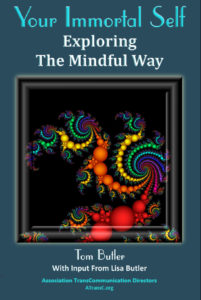
This essay is to explain the Visual Instrumental TransCommunication (ITC) study of possible ExtraTerrestrial (ET) beings. The study is named ET Visual ITC Study. ITC is discussed first because many readers may not be familiar with the more common characteristics of transform visual ITC.
The explanations used here are based on the Implicit Cosmology as described in the book, Your Immortal Self. The essays under the Concepts Tab of the Etheric Studies website describe the model and the Trans-Survival Hypothesis on which it is based.
Important to this discussion is the idea that a person is an immortal personality entangled with a human avatar for this lifetime. In that view, psychics and mediums are functionally the same, the difference is that a medium purposefully seeks to communicate with discarnate personalities. However, both mediumistic and psychic access of information are modeled as trans-etheric influences.
Also important is the idea that the objective formation of the visual and audible features of ITC is a transform phenomenon. That is, optical or audible chaotic noise is transformed into visual features or audible speech as the expression of intended order.
Instrumental TransCommunication
Transcommunication is a term used to describe communication between nonphysical and physical aspects of reality. Mediumship is transcommunication, as is psychic functioning. Instrument aided transcommunication is referred to as Instrumental TransCommunication or ITC.
Limits of Acceptability
To understand the limits of this study, it is important to understand the factors affecting the perception of visual ITC examples. As illustrated in the Relative Mainstream Acceptance of Paranormal Phenomena Diagram, the farther a concept is out on the frontier of knowledge, the less it is accepted by mainstream society. However, there are degrees of acceptability.

Intuition is generally accepted as an oddity of human nature and usually not closely scrutinized. Psychic functioning is widely accepted by parapsychologists if it is explained in terms of physical principles that may need to be expanded. Fewer parapsychologists accept any explanation for psychic functioning that requires duality, meaning mind is not a product of biological brain.
Psychic phenomena do not require continuation of personality after bodily death (survival hypothesis). Mediumship does, as it is presumably communication with discarnate personalities. The requirement of the survival hypothesis separates most parapsychologists from virtually everyone who thinks their ITC examples originate from dead people. Certainly, mainstream academia decisively discounts survival as pseudoscience (false science).
From my experience presenting audio and visual forms of ITC to audiences which included laypeople and academics, it has become clear that EVP might be acceptable as a strange hypothesis but visual ITC is so far out there that I have been repeatedly advised to stop talking about it lest I lose all credibility.
Thus, I have been reluctant to present examples of possible ET visual ITC. My assumption is that, if clearly human faces are not credible, clearly alien faces are beyond reason.
The point that needs to be understood for this study is that it is as far out on the frontier of knowledge as one can be. When you talk of this study with your friends, be sure to us objective terms such as study rather than believe.
About Visual ITC
The first question that needs to be answered is if examples of visual ITC are real or illusion.
The most common comment I hear in reference to visual ITC is that the examples are just pareidolia which means our mind is playing a trick on us and causing us to see patterns where there are none. Researchers often argue that people who believe in the existence of things paranormal are prone to pareidolia. However, virtually all of the research I have seen seemingly ignored the effect experiencing paranormal phenomena has on a person’s openness to future paranormal encounters.
ITC researchers do need to be familiar with Gestalt Psychology which holds that our mind naturally seeks to see relationships. For instance, three dots are likely seen to define a triangle. If someone is looking for a face in noise, three dots are almost automatically seen as two eyes and a nose.
The challenge is to find a way to certify that a proposed example of visual ITC is actually paranormal and not an accidental, naturally occurring arrangement of noise.
The “What do You See” Study
The first test for any paranormal phenomenon is to see if others can experience it in the same way without being told what to experience. In other words, is it objectively real or a mental experience?

We (ATransC) conducted an online “What do You See” visual ITC study. In 2016. In the Perception of Visual ITC Images report, you can see that of seven examples, the example with the highest agreement was a dog (left above) and a profile of a person (center), both at 81% agreement. At 28%, the least agreed on examples appeared to be a man’s torso (right), perhaps in ancient Asian garb. Based on these findings, it is arguable that at least some visual ITC examples exist as objective phenomena.
Characteristics of Visual ITC
The influence of thought on physical processes is modeled here as the expression of intended order. This comes from studies indicating that the output of Random Event Generators (REG) tends to become less random (increasing order) under the influence of attention or in proximity with a meditating person. For ITC, this effect is referred to as transform since the increasing order tends to assume intelligible shape.
The transform effect has been found to be more evident in the way visible features or discernable speech is sometimes found in chaotic noise. Thought is a conceptual process and physical noise is a physical, objective process. The model used here is that thought acts on the nonphysical concept representing the physical noise.
For instance, white noise is very deterministic in that each next sample is presumably as random as the preceding sample. The randomness of the signal is a very stable concept. By comparison, chaotic noise might be based on white noise, but is randomly punctuated by spikey noise to make it more unpredictable. The related concept is very indeterminant; not just random but random in a chaotic way.
We see this trans-etheric influence in the way visual ITC features tend to form in the mid-bright-dark, medium-texture regions of a photograph or video frame. Very dark and light are much more determinant, and of course, it is difficult to discern detail in saturated regions.
Transform rather than opportunistic examples
This study requires examples that are reasonably well-defined and that are decidedly paranormal. Opportunistic examples such as those that require distortion of the faces of living models or actual photographs cannot be accepted. A face found in vapor probably cannot be used because it will likely not be well enough defined. Faces found in mirrored images cannot be used because their paranormality is in question.
Holographic effect
In visual transform ITC it is common to have the same space occupied by more than one feature. For instance, the pixels forming the eye of one face might also be used to form the nose of another. The video-loop example here appears to be a small man with a hat. He is looking directly at you. There is a less well-formed face-like feature on the man’s hat, also looking at you. If you look closely in the third circle, there is a face-like feature forming a head looking toward your right shoulder. Not really visible in this example are many even less well-formed face-like features in the picture. (Note that the primary face seems to be appropriately colored.)

The best way I have found to describe this holographic effect is that we are impressing images representing our version of personalities in our etheric space of which we are unconsciously but not consciously aware.
In the Implicit Cosmology, I describe reality as life fields and their expression. We are not in our body. We are entangled with our body by way of what I refer to as the Attention Complex. Think of that as the seat of our mostly unconscious mind and where our perception and expression are formed. (That is where we share our worldview with our human avatar.) Refer to the Functional Areas of a Life Field Diagram on the right.
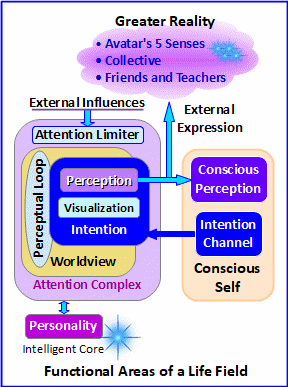
It is also argued in the Implicit Cosmology that we are the conduit for trans-etheric influences. That means we are mediumistically forming the ITC features by expressing intended order as informed by other communicating life fields. We and they are in the same space. Some of them have a body like us but most do not.
Although there appears to be no distance in etheric space, there is perceptual separation so that a life field I might be mediumistically aware of will seem close or distant, depending on the degree of rapport I have with it.
I am more aware of life fields that are perceptually close to me (greater rapport). Compare, for instance, the cousin I only met once years ago and my transitioned father. My link of rapport is much weaker with my cousin than with my father. Yet, I may unconsciously be impressing both as ITC. My cousin would be a very poorly formed feature if visible at all while my father’s would be much more apparent.
Because of our human’s instincts, we associate first the eyes and then the face with who a person is. In that way, it makes sense that we will more frequently transform noise into eyes, the top of faces and the rest in that order.
You may not be consciously aware of the personality associated with the face feature. Remember that, in this model, we are immortal and have likely had many lifetime experiences in this and other venues. Rapport is a perceptual link and not a physical one. We may well have greater rapport with a loved one from a prior lifetime than with anyone in this.
Please be mindful that this is a theory.
Visual ITC is a physical, two-dimension representation of three-dimension etheric space
Remember that, when examining examples of visual ITC, what we see is limited by our technology. If the greater reality is conceptual and without distance, and that is our natural habitat, our mental expressions of intention influences the technology in ways that we probably do not completely understand (yet).
The technology can only display in ways it has been designed. For instance, camera lens refraction index is selected to pass visible light frequencies. That means they tend to filter out frequencies that fall outside of their design range. If the communicating entity did produce far-infrared or ultraviolet, the camera—even modified ones—will probably not detect their light.
The same goes for the three-dimensional world of moving water and the two-dimensional world of the camera. We do not know what is being lost in the translation. When we see a face in the noise, are we just seeing that part of the face that is in focus?
As we examine our loopback video one frame at a time, we routinely rotate them in 90 Degree increments. Features are often difficult to make out and they do not easily register as a face when seen upside down or sideways.
Over the years, EVP experimenters have experimented using higher or lower than audible frequencies. Some have even decided that an example is not real unless it was recorded in the ultrasonic or infrasonic ranges. This ignored the fact that they had to convert the signal to the audible range for their recording equipment.
After years of examining the various theories and technologies—trying many ourselves—we made the executive decision that our communicators will communicate with us wherever we are looking so long as the physical conditions are right and the mental state of the practitioner or an interested observer is right.
Techniques
The common factor in both audio and visual transform ITC is the availability of chaotic noise. Chaotic noise is produced in the light reflected from moving water technique by agitating the water. Arthur Soesman introduced the ATransC to the technique by suggesting a colored jug partially filled with water. Photographing the moving water sometimes produced ITC.
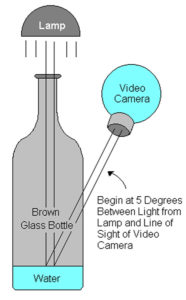 |
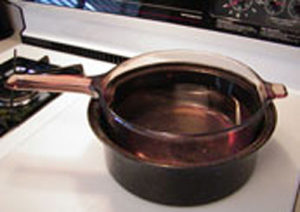 |
 |
I seldom pass up the opportunity to share Erland Babock’s light reflected from moving water example of the elfin children. Erland is transitioned now, but as we knew him as an ATransC member, he was one of the most competent ITC practitioners we knew. In this example, he used a brown glass jug in the Arthur Soesman technique. If you look closely, you will see two children, apparently wearing translucent mushroom-cap hats. Their back seems to be turned against a wind. Depending on how you focus on the features, there appears to be a small dog in front (downwind) of the smaller child. Above the taller child, and facing toward you, is a large creature not unlike the Star War’s Chewbacca. His hair is blowing in the wind. He appears to be watching over the children. Fanciful imagining? Maybe, but I always feel drawn to the scene as the better part of humanity.
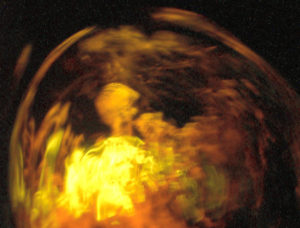
As far as we know, the video-loop feedback technique was developed by Martin Wenzel for Claus Schreiber. It involves a video camera set to record what is on a television screen. The output of the camera is fed into the Aux In of the television so that what the camera has just recorded is displayed on the screen. The result is a video loop producing very chaotic noise. While a television set tuned to a blank channel will produce snow-noise, looped video is chaotic with regions or order emerging in a very fast-moving display.
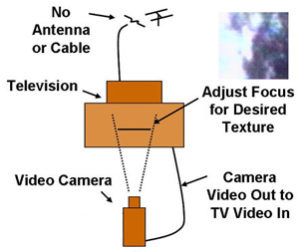 |
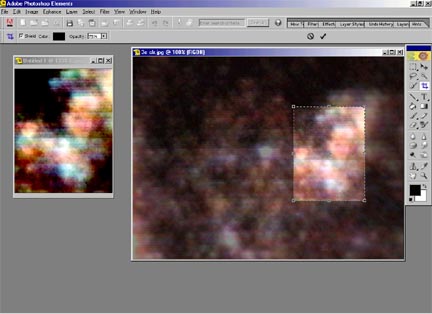 |
Look at my avatar at the top of my online biography. Then find that same feature in the video frame at the bottom of that page. That video frame is one of 30 per-second the camera makes during a session. Each promising frame (not all white or black) is examined, often turned upside down and sideways, as the features may show up anywhere. Most are difficult to find.
Now look at the video-loop example at https://atransc.org/video-loop-visual-itc-recording-technique/. It is possible for you to freeze the video-loop examples anywhere in the loop and expect to find a paranormal feature … at least a Class C.
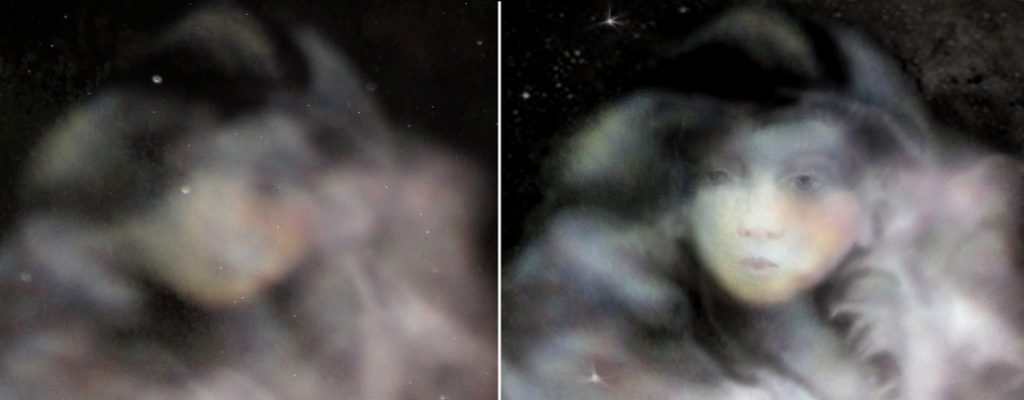 |
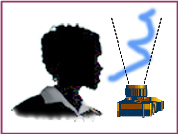 |
Vapor is sometimes used. Breath is used in the example shown here but vapor from an ultrasonic humidifier or even steam is sometimes used. The objective is to find paranormal shapes in photographs of the vapor.

Any source of chaotic noise is apt to produce ITC. In a photograph of a room, the medium-density regions sometimes have poorly formed features. JPEG compression noise often produces ITC. Technically, clouds photograph as chaotic energy. Interestingly, the glass surface of an old tube-type television screen sometimes produces reasonably well-formed features.
The example shown at the right was found on the screen of a turned-off rear-projection TV. Mr. D, as the owner of the pictures wanted to be identified, was experiencing a cluster of paranormal experiences, mainly orbs that were harassing his dog. He was trying to take a picture of an orb and found this man in his picture.
It is clear that even some of the most exotic visual ITC techniques are no more than novel ways of producing chaotic energy for transform ITC formation. Each technique has different advantages and disadvantages.
Video-loop can be expensive, and it is often difficult to establish useful noise. Resolution of the resulting features is limited by the resolution of the equipment meaning that they are often difficult to make out. Using mostly color analog equipment, we have color results. However, it is difficult to achieve a suitable video loop with color using all digital.
Moving water is easy to set up and any camera, light source and agitation technique will work. The results tend to be fewer features and they can be very distorted. Other than cost and ease of use, moving water results tend to be of higher resolution if a high-resolution camera is used.
Vapor techniques suffer from lack of definition. The extreme example is faces in clouds. While some may be paranormal, they are almost always too vague unless they are “enhanced” with art.
Probably not ITC
As directors of the ATransC, we have pledged to:
Do all we can to provide the most accurate and up-to-date information about all things etheric. While we do not know what will be seen as true in the future, we will attempt to identify what on this website is supported by empirical evidence, what is speculation and what is common knowledge.
After considerable study, personal experimentation and a lot of soul searching, we finally announced that radio-sweep probably did not produce EVP as designed but may inadvertently produce the occasional transform EVP in the resulting noise. If radio-sweep does produce EVP, it would be of the opportunistic kind and the techniques should be considered so full of false positives that it is useless for serious study.
In this essay, it is necessary for us to say that some popular techniques do not appear to produce visual ITC as intended but may inadvertently produce some possibly paranormal features in the resulting optical noise. In such techniques as using a photograph or even an actual person as the model for supposed transfiguration, and then partially obscuring the model with a translucent, often shiny or glittery cloth, the practitioner claims the resulting optically vague features are actually transfigured by a communicating personality. Rather than transformed features, techniques like this depend on creating vision-confusing ambiguity by obscuring a live form.
Using a mirror tool to fold parts of a photograph back on itself is a popular technique to produce face-like features out of the resulting symmetry. The claimed faces are virtually always ET-looking. They are artifacts of the technique and our human’s tendency to see just about any three dots as two eyes and a nose if they are symmetric. Without further research indicating the contrary, we must consider the mirror technique a simple sleight-of-hand parlor trick.
There are other questionable techniques we see around the Internet. In many cases, there is some support to think they may produce ITC, but in most cases, there is not enough study to know the difference between naturally occurring artifacts and actual paranormal phenomena.
Any technique for the collection of ITC examples needs to be supported by at least some study using well-considered protocols. We are happy to be proven wrong. Just show us the study reports.
The ET Visual ITC Study
The above information is intended to give you a sense of the nature of visual ITC. Except for the uninformed, the paranormality of visual ITC is not in question. However, the phenomenon has both a physical technology aspect and a mental aspect. We know examples are objective in that many people can share in the experience, but we do not understand the extent to which consciousness influences their formation and the witness’ experience.
The Implicit Cosmology model has been successful in describing many known characteristics of apparent paranormal experiences. The model predicts that the practitioner or an interested observer provides the conduit through which a psychokinetic influence is impressed on chaotic noise to produce an intended order. We do not know how much of the person’s worldview influences the final image, but based on current science, it is reasonable to argue that what we consciously experience is only a version of actual reality as it is colored by our worldview.
The Implicit Cosmology predicts that some of the external influences come from other minds. The Survival Hypothesis predicts that some of those other minds are discarnate personalities. The question of whether some examples of visual ITC represent real people is not settled science; some or all may be an objective product of our imagination.
The existence of Unidentified Flying Objects (UFO) of ExtraTerrestrial (ET) origin remains an open question. Finding apparent ET faces from visual ITC sessions is doubly dubious as far as science is concerned. To explore the possibility that some of those other minds are associated with persons living on other planets, we began a study for the ATransC titled the ET Visual ITC Study. The website is https://et-visual-itc-study.atransc.org/.
Possible ET ITC Examples

In a way, the study began quite a while ago. I put together the panel of five possible ET features shown above shortly after we assumed leadership of the ATransC. But back then, we hesitated to talk much about the ET aspect of ITC because we felt doing so would compound the confusion about an already confusing phenomenon.
Number (1), the “Blue-Faced Knight” example on the left was recorded by Lisa and me with a video-loop. He appears to be wearing an armored vest with shoulder guards. His collar is full-bodied, as if it is made of fur. He may be bald or have a very high forehead. His skin is decidedly blue.
Color in our video loop examples often seems to correctly represent the model for the example. Thus, we feel the blue is both unique for our examples and as intended by the source personality. Consider the way Hindu Gods are portrayed with blue skin. From Why are Hindu Gods Blue-skinned? we see that the Hindu god’s blue skin is apparently a relatively recent representation. It is nevertheless interesting that we have an example of an apparently blue-skinned knight.
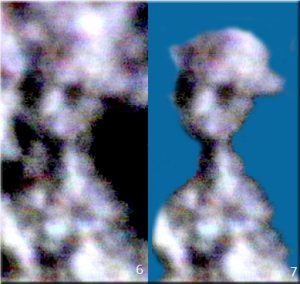
Next is Number (4), the insect-like being. It was recorded by us with a video-loop. It appears to have a bony bump on its head and a relatively long snout. The eyes are big and situated more to the side of the head. It appears to have a long neck.
Compare Number (4) with the example (6) on the right. Because of the way video-loop features are formed in optical noise, they are typically partially obscured by untransformed noise. As I remember, the left version may have been adjusted some for contrast but is otherwise unchanged. I have erased the untransformed noise based on my best guess for the version on the right, (7). Consider the version on the right side a suggestion and possibly incorrect. The point is that the Example (4) in the Possible Aliens gallery and version (6) here seem to represent the same species.
Compare (2), the “Gremlin,” recorded by Jose Garrido and Alfonso Galeano with (3), the one recorded by Erland Babcock. Both are video-loop examples. (Both were recorded with component video equipment, as opposed to our modern integrated camcorders.) Note the horizontal pointing ears and round head. Lisa and I recorded a similar figure but it is of such low quality that we dare not try to display it. The important characteristics are the ears, shape of the head and apparent slight build. Our version has a point on the top of its head like a tuft of hair. There may be one in the Babcock version (3), but none is apparent in the Garrido and Galeano version.
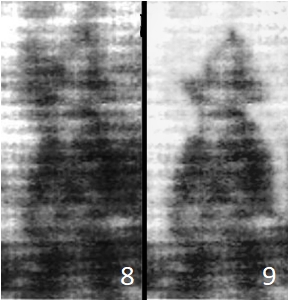
The sitting man shown (5) is also shown in (8) above. While it is common to have distorted features, the very large chin and relatively small scull seems consistent with the rest of the feature. The background has been erased for version (9) to make it a little easier to make out the shape. It may be that we are seeing a bench he is sitting on. If so, I may have erased trees behind him. This was an all-grayscale video frame and it is difficult to know with any certainty.
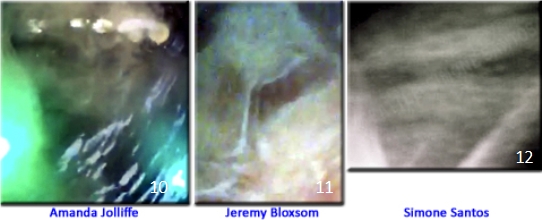
Beings with wedge-shaped heads seem to be pretty common. In Example (11) by Jeremy Bloxsom and (12) by Simone Santos, it appears the head shape may be at least partially an artifact of the technique. We need to learn more to know for sure. Example (10) offered by Amanda Jolliffe compares well with Example (11) in that the brow line and nose ridge both have the same sharp, “Y”-shape. All three have a relatively small mouth.
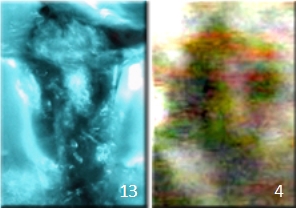
Margaret Downey collected an example using light reflecting from moving water (13). It is shown here with the insect-like being (Example 4) Lisa and I recorded. I am comparing them because both have a longer-than-human snout and eyes at the side of their head. On close examination, Example (13) may have jowls and more of a camel-like face while Example (4) seems more insect-like.
Possible Benefits
Here are the objectives of the study:
- Gain further understanding about the paranormality of visual ITC features.
- Determine if there is sufficient agreement amongst witnesses to propose that some visual ITC examples may represent one or more ET species.
- Determine if it is possible for more than one practitioner to collect one or more examples that are possibly of the same ET species.
- If so, determine if there is sufficient information to identify a trend suggesting they are part of an off-world race of beings?
- Determine if one or more contactees will recognize any of the possible ET species identified in Item 4.
- By contemplating an example that seems to represent an ET species, is it possible for a practitioner to request that their feature appear in a visual ITC session?
- Establish a database of possible ET visual ITC examples and reports that is suitable for academic reference.
Given our present level of understanding, it is probably unreasonable to try to develop more information about the examples, but we are not trying to prove the existence of ETs. We are trying to gather information about these features to see if we can establish usefully objective models for them.
Submissions
Here are the current examples that we are asking you to help us grade. You can access the grading web page using the link associated with the “Submission #” entry.
 |
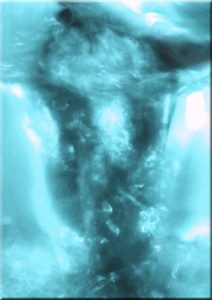 |
 |
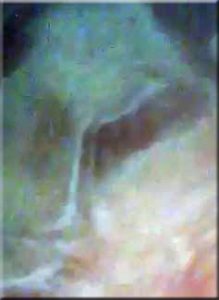 |
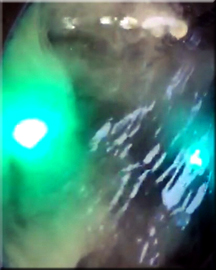 |
 |
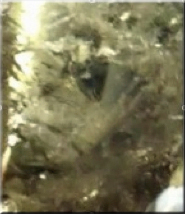 |
 |
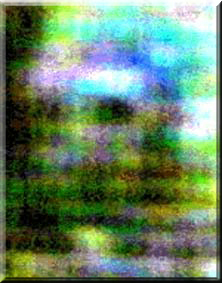 |
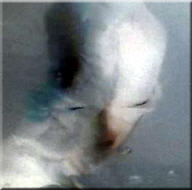 |
 |
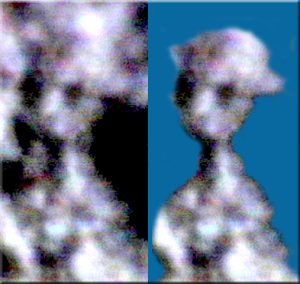 |
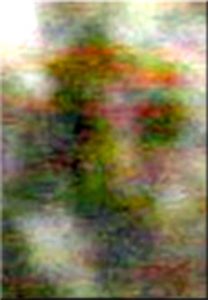 |
Questions?
There are three very profound points implied by this study. First, it is based on the assumption that visual ITC is a real phenomenon that many people can produce, experience and possibly apply in future studies.
Second, that there is sufficient reason to think some of the examples represent off-world life forms to conduct the study in the first place.
The last point has a direct implication on who we are as life forms. Lacking a physical explanation for the existence of these features, it becomes necessary to seriously consider a nonphysical explanation that may include survived personality.
Your participation in this study by submitting completed forms for one or all of the examples will help us determine the three points are real or fanciful.
![]()

